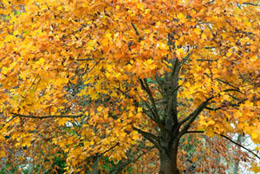The tulip tree or the tulip poplar tree is a giant tree, known to produce tulip-like yellow flowers. It is an ideal tree for landscaping, and is widely used for this purpose in North America. Find out some interesting facts about this tree, and how to grow and care for it, by going through this Buzzle write-up.

The tulip poplar tree belongs to the family
Magnoliaceae or magnolia, and is native to North America. It is commonly known as the tulip tree and yellow poplar. The scientific name of this tree is
liriodendron tulipifera. Another species of the tulip poplar tree is
liriodendron chinese, which is native to China and Vietnam. The tree got the name tulip poplar, as its flowers resemble the tulip flowers. However, this tree is not related to the tulips and the poplars. It can be easily identified by its massive size and height.
Tulip Poplar Identification
As mentioned already, it is a large, shady tree that can reach a height of about 150 to 165 feet. So, this tree can easily surpass other surrounding trees, including the maple and oak trees at times. Some tulip poplars can reach a height of more than 170 feet.
This giant and magnificent tree can also be identified by the shape of its large and unique foliage. The leaves of this tree have four lobes and a pointed apex. The characteristic lobes are deeper in a young tree, as compared to a matured one. The leaves of this tree are quite large with a length of 8-22 cm, and a width of 6-25 cm.
Its beautiful flowers are bright yellow in color with orange bands, and they appear in May and June. A typical tulip poplar flower is about 3 to 10 cm in diameter with nine petals. The flowers are known to have a faint smell of cucumbers. The tree generally takes almost 15 years to produce blossoms. It also produces cone-shaped fruits, which are actually an aggregate of samaras.
In fall, when all other trees start to lose their foliage and turn brown, this magnificent tree changes its color from fresh green to golden-yellow, which undoubtedly creates a spectacular sight. For this reason, it is a preferred option for landscaping in many parts of the United States. It is the state tree of Tennessee, Indiana, and Kentucky. The wood of the yellow poplar is used for making inexpensive furniture, cabinet and furniture framing, and sub-surfaces for veneering.
How to Grow a Tulip Poplar
The tree grows very rapidly, reaching a height of about 15 to 20 feet within a short period of 6 to 8 years. You can plant this tree in spring, either by using the seeds or any vegetative part. However, flowering occurs earlier in grafted plants than those grown from seeds. A wet, but well-drained, and slightly acidic soil is ideal for growing this tree, though it can also tolerate slightly alkaline and salty soils. It prefers temperate climates, and places partly exposed to sunlight. Moderate watering is enough to ensure the healthy growth of this tree.
Regular pruning is important to maintain its shape, which tends to become irregular at maturity. Pruning helps maintain the regular oval or conical shape of the tree. The tulip poplar tree is usually resistant to a large number of diseases and insects. However, you may occasionally encounter some common tulip tree diseases, like cankers, leaf spot, powdery mildew, verticillium wilt, and sooty mold. The tree may also attract some undesirable insects like aphids, bees, and wasps. In spite of its susceptibility to all these diseases and pests, the tulip poplar tree can be a great addition to a yard due to its majestic look.






 The tulip poplar tree belongs to the family Magnoliaceae or magnolia, and is native to North America. It is commonly known as the tulip tree and yellow poplar. The scientific name of this tree is liriodendron tulipifera. Another species of the tulip poplar tree is liriodendron chinese, which is native to China and Vietnam. The tree got the name tulip poplar, as its flowers resemble the tulip flowers. However, this tree is not related to the tulips and the poplars. It can be easily identified by its massive size and height.
The tulip poplar tree belongs to the family Magnoliaceae or magnolia, and is native to North America. It is commonly known as the tulip tree and yellow poplar. The scientific name of this tree is liriodendron tulipifera. Another species of the tulip poplar tree is liriodendron chinese, which is native to China and Vietnam. The tree got the name tulip poplar, as its flowers resemble the tulip flowers. However, this tree is not related to the tulips and the poplars. It can be easily identified by its massive size and height.